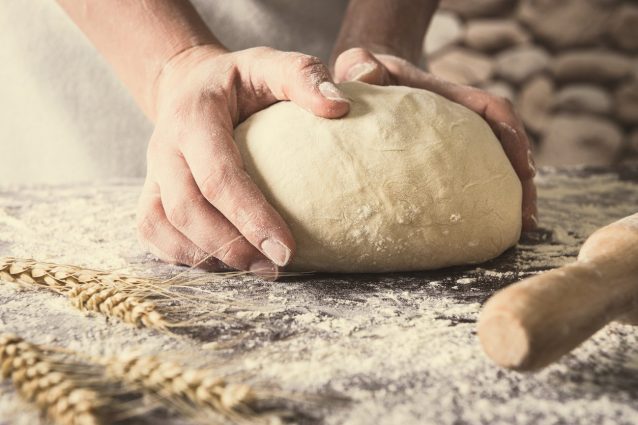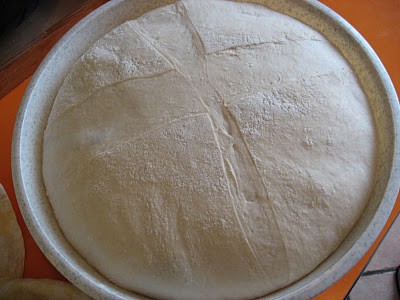Best Homemade Tuscan Bread: the Recipe from Tuscany in Italy

I often enjoy preparing it at home, especially on special occasions or on Sundays.
A Story about Tuscan Bread
My mother Anna always tells me how incredibly delicious the bread prepared by her grandmother was; and from the enthusiastic way in which she speaks, I can only imagine how wonderful and tasty it really was. The bread was made even more savory as it was cooked in old wood ovens! Bread was prepared only once a week, but it was so good and genuine that it kept well for many days. Women worked all ingredients by hand on the madia or kneading trough; a rustic piece of furniture.
Is salt necessary in bread making?
Now I’ll show you the bread recipe I’ve learned from my mother, and although the actual Tuscan bread recipe is without any salt in it, I put just a pinch of it in my dough, as my mother does.
The traditional and authentic Tuscan Bread Recipe is totally made with no salt and requires many hours of leavening.
Note: to have a good bread you need to use only high quality products, starting from the flour, that’s extremely important!
Ingredients needed to make Bread at home
- 1000 gr (=2.205 pounds= 7 cups) of soft flour (type 0)
- 700 ml (=2.959 pounds= 3 cups) of warm water
- a pinch of salt
- 6 spoons (50 gr) (=0.110 pounds) of extra virgin olive oil
- 2 teaspoons of sugar (10 gr) to help leavening
- 14 gr of powder yeast (=4 1/2 teaspoons dry yeast) or 25 gr of brewer’s yeast
How to make Homemade Tuscan Bread?
*Note: I recommend you make your bread pastry absolutely by hand on a wood board.
1. First of all you need to dissolve the yeast together with the warm water; until it is completely melt. Note that the water has to be just lightly warm.
2. Put the flour in another basin and add the water with the yeast in it little by little, then add all other ingredients and work the pastry very well on a board for at least 10 minutes.
3. Put the pastry in a basin, cover it with a damp cloth and let it leaven for no less than 2 hours, in a warm area of the kitchen. Once the dough is raised (it should double its volume), you have to work it all again by using some flour, then divide it in 2 or more parts, cover again with a damp cloth and let rest for another hour.
How to bake bread in the oven?
4. Finally cook it in the oven at 230 °C (Celsius corresponding to 450 °F Fahrenheit) for about 20 minutes, and then for other 20 minutes at 200 °C (390 °F), until your bread gets of a brownish color, or according to your preferences.
My Tips to Have a Great Tuscan Bread:
- If you are going to make bread at home, never be in a hurry! It takes at least three hours in all to make the bread rise properly.
- The main feature of Tuscan bread, besides its lack of salt, is that it has to be particularly soft inside. This requires long rising times. To have a great Tuscan bread soft inside, you need to let the dough very soft, even mushy, this is the reason why the quantity of water is more in comparison to other bread recipes.
- How to have a crisp and crumbly crust? Once bread is cooked, turn off the oven and leave bread inside it for another 10 minutes so to get a crisper crust. Remove and let cool. A further tip to have a crusty bread is to put a little pan full of water in the oven and leave it there in the first cooking stage (20 minutes).
- Homemade bread keeps well also for some days, it may be a good idea to warm it up in the oven just before eating it; in case you like it warm like me 🙂
Your Tuscan bread is finally ready! The wonderful smell of your homemade bread will fill your home! I love it 🙂
Ask me for any question about making your own first Tuscan bread! Write your comment below.









The temperatures in this recipe are Celsius, but they’re not marked as such. So if you’re in the US, you need to convert them to Fahrenheit … 230C is roughly 450F, 200C is roughly 400F.
Dear Ronald! You are right! Thanks a lot for letting us noticing it, I’ve just made it clear in the post 🙂
I live in Australia, so can you tell me what is 700gm of water please? ;D
Dear Jeanette, 700 g corresponds to 700 ml of water, if it’s still not clear let me know 🙂
I live in the USA. Would you please convert the recipe into cups ounces and so on. Also what is considered a little spoon. Thank you
Ciao Randy, a little spoon corresponds to 1 teaspoon (5 gr). While I’m working on the conversions to update the recipe, please have a look at this site for making conversions into cups etc
Hey! I’m going to try this… but what pan do you suggest for cooking the bread in??? Some have told me a dutch overn or similarly shaped deep casserole/oven safe dish.
I lived in Florence for a year a few years ago and I’m craving the pane!
Dear Joanna,
Thanks for getting in touch 🙂 any oven pan would be ok, as I always use baking paper to cook it! The pans I use are not too deep.
Let me know how it comes out! Viva il pane 🙂
elena
Please convert recipt so I can try it, Ilive in Pa.
Dear Connie, thanks for your message. I’ve now updated the recipe converting measures. Let me know if it’s all clear 🙂
Hello
Your recipe calls for salt but the comments about Tuscan bread say that there is no salt. Shall I omit the salt?
Hello Laurie
Salt in the recipe is just 10gr, so use it! We say that Tuscan bread is without salt in comparison to all other types of Italian bread that are very salty 🙂
Hi
I just made a Tuscan bread, it is in the oven…. well I was not sure if I have to preheat the oven to 230 C ….also I selected the Conventional program. any advice regarding this?
Hi Mimi!
The oven needs to be preheated!
How is your bread? tell me!
Have a nice day!
elena
Hi Elena, I have a wood fired oven any suggestions on your recipe for cooking it in there? Thanks a lot have a great day .
Dear Mark,
Bread in the a wood fired oven is superb! Here are some tips about cooking it in the oven:
-The oven has to be cleaned very well
-The oven must be switched on 5-6 hours before use, so that it reaches the right temperature.
-It is always better to leave a pan of water in the wood oven when bread or pizza are baked
-The bread is cooked when tapping your knuckles over the bread you hear a hollow sound.
Enjoy making your bread! 🙂
HI … this bread looks delicious and I can’t wait to try making it. I was always taught that Tuscan bread doesn’t have any salt in it though. The people in Tuscany were like screw you…taxing our salt so high . We will show you by making delicious bread with no salt 🙂
I am preparing this recipe now but I am uncertain as to how many loafs it will yield as you mentioned to separate into one or more pieces. Do I add it back together at some point or cok more than one load? My question may be answered when it rises but I am certainly not a chef or a baker be any means
Hello James! Here I am, thanks a lot for coming here 🙂
You should separate the dough in 2 or also 3 loafs after the first 2 hours of leavening. Then you’ll not have to put all together again, but put the loafs directly into the oven. In case you prefer to have smaller loafs of bread it can be ok also to separate the first dough into 4 parts, but no more than that. Let me know about the result! For any other tip, I’m here!
elena
Hello, your Tuscan bread recipe has salt as an ingredient, yet you mention ‘…it’s lack of salt…’
I have lived in Tuscany, and tuscan bread has no salt in it. Perhaps you might clarify in your recipe that you have adjusted it perhaps to (North American?) tastes.
Hello Rolf, thanks a lot for your message! I appreciate it as it helps to clarify the recipe. In the recipe I explain that this is the bread recipe I’ve learned from my mother, and she, in turn, had learned it from her grandmother. As also told in other comments in this post, the original recipe for Tuscan Bread should not include any salt, but the quantity of salt I put in the recipe is just 10gr, a little more than a pinch of it. So you eat the bread and its taste is actually without salt. I will make this more clear also in the recipe 🙂
Elena, grazie absolutely gorgeous. I use sourdough starter for even deeper earthy tones. Love your pages
Ciao David 🙂 Great! sourdough starter is actually the best to use 🙂 Happy you like my pages, keep in touch then! Ciao from Florence
How much starter do you suggest?
Ciao from Tuscany Jen:-)
I would suggest to use 200 or 250 gr of stater (what we call Lievito Madre) for each kilogram of flour.
Elena
Can this bread be frozen? Can the dough be frozen for future baking? There are only two of us in the family and I don’t want to waste.
Ciao Galyn, thanks for your message! Sure! Absolutely 🙂 the dough can be frozen for future baking, ciao from Tuscany!
Elena could you possibly convert the measurement for the olive oil? I’m confused because you show two teaspoons (small spoons) of sugar for 10 grams … but I think that would make 50 grams of olive oil 10 spoons?
I’m so sorry! I am in ny … I am unfortunately very limited with other measurements than those we use here!
Thank you so much for your help.
We are locked down because of coronavirus … I am missing Italian bread
Dear Judy 🙂 so happy you are contacting me in this difficult period for all of us, we are locked down because of the Coronavirus also here in Italy, so I send you a big kiss to you and the wonderful New York!
1 spoon of olive oil corresponds to about 8-10 gr or sometimes more, depending on how large is the spoon, so 50 or 60 gr is ok (6 spoons). No need to weight the exact quantity in grams, and note that the more oil you’ll put in the dough, and the more soft your bread will be inside. A small spoon or teaspoon, corresponds to about 5gr of sugar for example. Hope to have been clear and please contact me again for any other question 🙂 Please also send me the photos of your Tuscan bread 🙂 I think we are all eating a lot these days! Elena
Dear Elena
Great recipe works every time. I have slightly reduced the amount of water to get it perfect in my conditions.
Thanks so much.
Alan
Dear Alan! It’s a pleasure to hear that 🙂 So happy you made bread! If you wish you can also share your photos! Ciao from Tuscany 🙂
Elena,
I just found your recipe for pane Toscano. I had the pleasure of living in Firenze for a year, way back during college. We were forced to find our own accommodations and immerse ourselves into the fabric of the city. One of the things that I miss so much is buying fresh loaves of bread for our neighborhood panetteria. It took a while for me and my roommates to get used to the hard, sharp crust and the lack of salt, but after a few months we couldn’t get enough. In the years since I was there, I have never found a store, shop, or restaurant that offered Tuscan bread(I live in Southern California) I can’t wait to try your recipe, I’ve already found a good bottle of olive oil.
Dear Jesse, what a pleasure to receive your message! 🙂 Tuscan bread is actually unique, when it is done well it comes irresistibile, especially with olive oil and fresh tomatoes! Please let me know the result for your home made Tuscan bread! Kisses from Florence, elena
Hi
You say ‘work it all again’, does this mean ‘knock it back’ or knead again. If it’s to be kneaded again, for how long?
Can the bread be proved in a banneton? Can it be cooked as one large loaf?
Thank you.
Aiza loves recipe so yummy my whole family loved it thanks
🥰🥰🥰🥰
You are off on the flour conversion. I made it with 10c and realized that 1000 grams is 6 cups. Ugh. We are hoping we were able to save it with some quick thinking on our side but we will see in a few hours! 😬
Ciao Matthew, so sorry for that! the fact is that converters online actually give different number of cups! I’ve checked and checked again, and 1000 gr of Flour type 0 (bread flour) actually corresponds to 7 US cups, not 6! The fact is that it also depends from the type of flour, for instance, in the case of all purpose flour, 1000 gr corresponds to 8 Us cups. take a look Grams to cups conversions. What happened then to your bread?
What kind of flour? Bread flour or all purpose? Also can I use a mixer with a couch hook to knead or do it by hand only?
I cannot find type 0 flour..what is it equivalent to? Thank you..